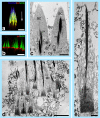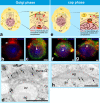Diverse functions of myosin VI in spermiogenesis
- PMID: 33386429
- PMCID: PMC8021524
- DOI: 10.1007/s00418-020-01954-x
Diverse functions of myosin VI in spermiogenesis
Abstract
Spermiogenesis is the final stage of spermatogenesis, a differentiation process during which unpolarized spermatids undergo excessive remodeling that results in the formation of sperm. The actin cytoskeleton and associated actin-binding proteins play crucial roles during this process regulating organelle or vesicle delivery/segregation and forming unique testicular structures involved in spermatid remodeling. In addition, several myosin motor proteins including MYO6 generate force and movement during sperm differentiation. MYO6 is highly unusual as it moves towards the minus end of actin filaments in the opposite direction to other myosin motors. This specialized feature of MYO6 may explain the many proposed functions of this myosin in a wide array of cellular processes in animal cells, including endocytosis, secretion, stabilization of the Golgi complex, and regulation of actin dynamics. These diverse roles of MYO6 are mediated by a range of specialized cargo-adaptor proteins that link this myosin to distinct cellular compartments and processes. During sperm development in a number of different organisms, MYO6 carries out pivotal functions. In Drosophila, the MYO6 ortholog regulates actin reorganization during spermatid individualization and male KO flies are sterile. In C. elegans, the MYO6 ortholog mediates asymmetric segregation of cytosolic material and spermatid budding through cytokinesis, whereas in mice, this myosin regulates assembly of highly specialized actin-rich structures and formation of membrane compartments to allow the formation of fully differentiated sperm. In this review, we will present an overview and compare the diverse function of MYO6 in the specialized adaptations of spermiogenesis in flies, worms, and mammals.
Keywords: Actin; C. elegans; Drosophila; Mouse; Myosin VI; Spermiogenesis.
Conflict of interest statement
The authors declare that they have no conflict of interest.
Figures








Similar articles
-
Myosin VI maintains the actin-dependent organization of the tubulobulbar complexes required for endocytosis during mouse spermiogenesis†‡.Biol Reprod. 2020 Apr 15;102(4):863-875. doi: 10.1093/biolre/ioz232. Biol Reprod. 2020. PMID: 31901088 Free PMC article.
-
Loss of myosin VI expression affects acrosome/acroplaxome complex morphology during mouse spermiogenesis†.Biol Reprod. 2020 Aug 21;103(3):521-533. doi: 10.1093/biolre/ioaa071. Biol Reprod. 2020. PMID: 32412041 Free PMC article.
-
Filopodia formation and endosome clustering induced by mutant plus-end-directed myosin VI.Proc Natl Acad Sci U S A. 2017 Feb 14;114(7):1595-1600. doi: 10.1073/pnas.1616941114. Epub 2017 Jan 31. Proc Natl Acad Sci U S A. 2017. PMID: 28143933 Free PMC article.
-
The MYO6 interactome: selective motor-cargo complexes for diverse cellular processes.FEBS Lett. 2019 Jul;593(13):1494-1507. doi: 10.1002/1873-3468.13486. Epub 2019 Jul 3. FEBS Lett. 2019. PMID: 31206648 Review.
-
[Myosin VI: the unique motor protein of the actin cytoskeleton].Postepy Biochem. 2011;57(1):63-73. Postepy Biochem. 2011. PMID: 21735821 Review. Polish.
Cited by
-
Contribution of labor related gene subtype classification on heterogeneity of polycystic ovary syndrome.PLoS One. 2023 Mar 1;18(3):e0282292. doi: 10.1371/journal.pone.0282292. eCollection 2023. PLoS One. 2023. PMID: 36857354 Free PMC article.
-
Lagging X chromatids specify the orientation of asymmetric organelle partitioning in XX spermatocytes of Auanema rhodensis.Genetics. 2022 Nov 30;222(4):iyac159. doi: 10.1093/genetics/iyac159. Genetics. 2022. PMID: 36255260 Free PMC article.
-
TMPRSS12 Functions in Meiosis and Spermiogenesis and Is Required for Male Fertility in Mice.Front Cell Dev Biol. 2022 Apr 25;10:757042. doi: 10.3389/fcell.2022.757042. eCollection 2022. Front Cell Dev Biol. 2022. PMID: 35547804 Free PMC article.
-
Myosin VI Is Associated With the Endoplasmic Reticulum in Regions of Sertoli Cells Containing Tubulobulbar Complexes.Cytoskeleton (Hoboken). 2025 Jun;82(6):333-343. doi: 10.1002/cm.21949. Epub 2024 Oct 10. Cytoskeleton (Hoboken). 2025. PMID: 39390674 Free PMC article.
-
Exploring the impact of lipid stress on sperm cytoskeleton: insights and prospects.Nat Rev Urol. 2025 May;22(5):294-312. doi: 10.1038/s41585-024-00952-1. Epub 2024 Nov 11. Nat Rev Urol. 2025. PMID: 39528754 Review.
References
-
- Adams A, Vogl AW. High resolution localization of Rab5, EEA1, and nectin-3 to tubulobulbar complexes in the rat testis. Anat Rec (Hoboken) 2017;300:1160–1170. - PubMed
-
- Adams A, Sriram A, Vogl AW. Internalization of intact intercellular junctions in the testis by clathrin/actin-mediated endocytic structures: tubulobulbar complexes. Anat Rec (Hoboken) 2018;301:2080–2085. - PubMed
-
- Ameen N, Apodaca G. Defective CFTR apical endocytosis and enterocyte brush border in myosin VI-deficient mice. Traffic. 2007;8:998–1006. - PubMed
-
- Anahara R, Toyama Y, Maekawa M, Kai M, Ishino F, Toshimori K, Mori C. Flutamide depresses expression of cortactin in the ectoplasmic specialization between the Sertoli cells and spermatids in the mouse testis. Food Chem Toxic. 2006;44:1050–1056. - PubMed
Publication types
MeSH terms
Substances
Grants and funding
LinkOut - more resources
Full Text Sources
Other Literature Sources
Molecular Biology Databases
Research Materials

